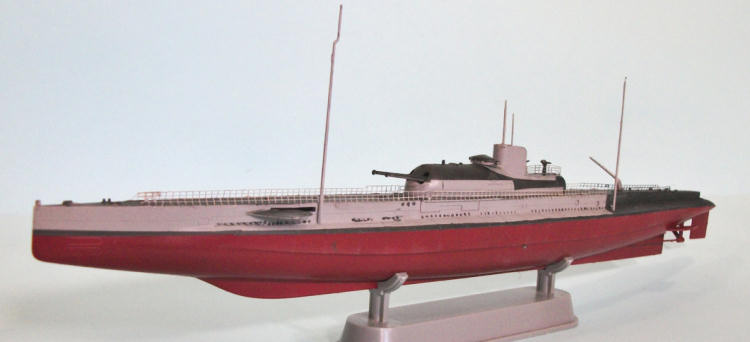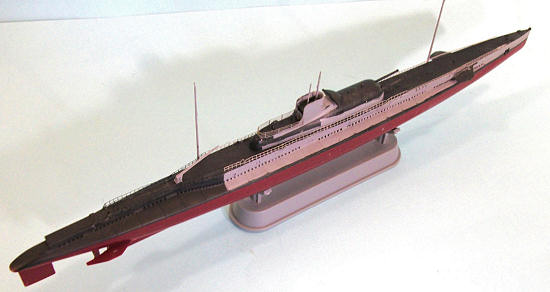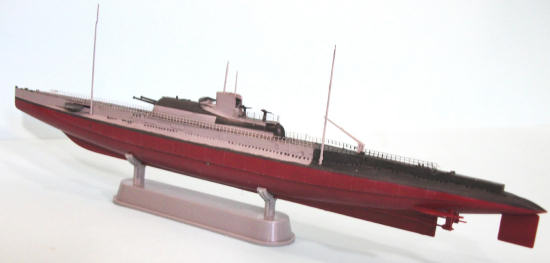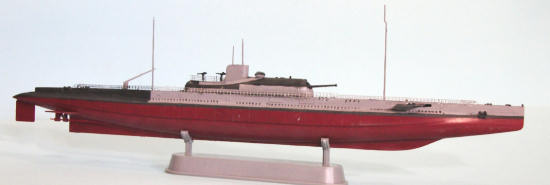
Hobby Boss 1/350 Surcouf
| KIT #: | 23522 |
| PRICE: | 2400 yen from www.hlj.com (about $31.00) |
| DECALS: | One option |
| REVIEWER: | Tom Cleaver |
| NOTES: | New tool kit |

| HISTORY |
Surcouf is easily the strangest submarine to ever be operated by
any Navy, and one whose career is still shrouded in mystery. Named for a famous
French “privateer,” Robert Surcouf, it was more a submersible cruiser than it
was a submarine, and was a one-of-a-kind in more than one way, being the only
submarine ever built with a prison compartment capable of holding 40 prisoners.
When the Washington Naval Treaty of 1922 failed to place any limits in
submarines, the French Navy under Admiral Drujon undertook the design of an
“undersea cruiser” that would operate on the high seas as a commerce raider,
submerging only to creep up on an unsuspecting target or to evade surface ships
sent to find it. Her two 8-inch
guns would provide her with the ability to fight it out with any warship less
than a heavy cruiser. Surcouf
was the first of what was planned to be seven of these submarines, later reduced
to three; at the time she was launched in 1929 she was the largest submersible
warship in the world, and would only be exceeded by the Japanese I-400 class
submarines in 1944. The
 The concept of an “undersea dreadnought” was first experimented with by
the Royal Navy in 1916, when “M-1", armed with a single 8-inch gun, was launched
in July 1918. The submarine never
saw combat, and the British realized they had more to lose by other navies
adopting the concept, due to their extensive merchant marine.
The submarine “X-1,” which was to be armed with four 5.9-inch weapons in
two turrets, was launched in 1921 and was also a failure. The British made sure
to tell their friends the Japanese about the failed concept, to head off any
developments the Imperial Navy might be planning.
The concept of an “undersea dreadnought” was first experimented with by
the Royal Navy in 1916, when “M-1", armed with a single 8-inch gun, was launched
in July 1918. The submarine never
saw combat, and the British realized they had more to lose by other navies
adopting the concept, due to their extensive merchant marine.
The submarine “X-1,” which was to be armed with four 5.9-inch weapons in
two turrets, was launched in 1921 and was also a failure. The British made sure
to tell their friends the Japanese about the failed concept, to head off any
developments the Imperial Navy might be planning.
Surcouf was commissioned in 1934.
361 feet in length, she displaced 3,304 tons on the surface and was
powered by two large 3,800‑horsepower diesel engines, giving her a top speed
surfaced of 18 knots and 10 knots submerged. She carried sufficient fuel to give
her a range of 10,000 miles and could carry enough supplies for a 90 day cruise.
Her crew numbered eight officers and 110 enlisted men.
In her intended role as a commerce raider, she had the aforementioned
prison compartment, and carried a small Besson MN‑411 floatplane in a hanger aft
of the tower to scout for victims and spot for her main battery.
The two 8-inch naval cannon were carried in a special watertight turret
forward of the conning tower, with two 37mm anti-aircraft guns on the deck aft
of the bridge. Additionally, she
was equipped with four bow tubes armed with 21.7" torpedoes and two quad-mounted
tubes at the stern were armed with the fast but short‑ranged 15.7" torpedo.
She carried a total of fourteen 21.7" and eight 15.7" torpedoes.
In operation, Surcouf quickly proved to be a failure. Her very
complex design insured she was constantly plagued by mechanical troubles. Trim
was difficult to adjust during a dive, which took over two minutes to get to a
dept of 40 feet, making her vulnerable to searching aircraft, while on the
surface she rolled badly in rough seas.
Between 1935-39, Surcouf made several “show the flag” cruises to
overseas ports of call, covering more than 16,000 miles, all on the surface.
The outbreak of war in September 1939 found her in the French
 Surcouf was still under repair when the German blitzkrieg
struck in May. With the Germans
rapidly approaching
Surcouf was still under repair when the German blitzkrieg
struck in May. With the Germans
rapidly approaching
Only two officers and 14 men of the crew agreed to remain as part of the
Free French Navy, which meant that a new crew would have to be recruited among
Frenchmen on British territory.
Given the size of the crew she needed, the British planned to leave her
decommissioned, but the Free French saw her as a symbol, and persevered in
re-commissioning her. The new crew
was largely inexperienced, though attempts were made to find anyone with
knowledge of the sea, including a Breton fisherman.
Her first cruise with the new crew in October revealed their
inexperience. The British still
distrusted the French, and placed a British officer and two signalmen aboard as
liaison. While this was standard
procedure with other navies‑in‑exile serving with the Royal Navy and worked well
with other crews, tensions were always high aboard Surcouf.
Surcouf was regarded as the pride of the fledgling Free French
Navy by De Gaulle, and as a joke by the Admiralty. After brief training with the
Third Submarine Flotilla in the
Sent back to Canada, she made one more convoy escort in June, before
being sent to the U.S. Navy Base at Portsmouth, N.H., in late July for further
repairs that lasted until November 11, 1941.
Due to there being no spares available, only some of her problems could
be addressed.
Stopping briefly at the
 That evening, the captain of Surcouf was approached by New York
Times reporter Ira Wolfert, who questioned him about the rumor that the
submarine would liberate the small islands of Saint‑Pierre and Miquelon, the
last French territory in North America about 5 miles off the coast of
Newfoundland, from Vichy control.
What happened next is in dispute, but the story was that the Captain
kidnaped Wolfert to keep him from telling the story further, and took him aboard
Surcouf. What is not in
dispute is that later that evening Surcouf, along with Mimosa, Alysse,
and Aconit, left Halifax harbor under Muselier’s command for “maneuvers.”
On December 24, the submarine landed sailors on the islands and took
control for Free
That evening, the captain of Surcouf was approached by New York
Times reporter Ira Wolfert, who questioned him about the rumor that the
submarine would liberate the small islands of Saint‑Pierre and Miquelon, the
last French territory in North America about 5 miles off the coast of
Newfoundland, from Vichy control.
What happened next is in dispute, but the story was that the Captain
kidnaped Wolfert to keep him from telling the story further, and took him aboard
Surcouf. What is not in
dispute is that later that evening Surcouf, along with Mimosa, Alysse,
and Aconit, left Halifax harbor under Muselier’s command for “maneuvers.”
On December 24, the submarine landed sailors on the islands and took
control for Free
Wolfert’s very positive article appeared in the New York Times, and set
off a political fire storm. The
United States still recognized Vichy as the legitimate government of France;
under the Monroe Doctrine only the United States could interfere in the
political orientation of any country in North or South America.
In the end, DeGaulle and the Free French ignored the American protests,
which was a major reason why Franklin Roosevelt spent most of the rest of the
war searching to support anyone but DeGaulle as the leader of Free France, an
issue that would only be resolved when Paris was liberated in August 1944 and
DeGaulle was installed as the first President of the Fourth Republic.
With the islands under Free French control, Surcouf returned to
And now the story becomes even stranger.
Despite the fact that Surcouf was not totally seaworthy, she was
ordered to the Pacific, to operate from
Surcouf
never arrived. The American
freighter S.S. Thompson Lykes reported striking what was assumed to be a
German U-boat east of
 Other tales include Surcouf operating from
Other tales include Surcouf operating from
James Rusbridger in “Who Sank Surcouf?” concludes that the records of the
6th Heavy Bomber Group, operating out of Panama, report the sinking of a large
submarine the morning of February 19, 1942; since no German submarine was lost
in that area on that date, it could only have been Surcouf.
Rusbridger postulates that damage from the collision with Thompson
Lykes damaged the radio so that Surcouf could not identify herself,
and she was thus sunk by “friendly fire.”
The official French position is that she was sunk by Thompson Lykes,
with Rear Admiral Jean Auphan, author of “The French Navy in World War II”
stating “for reasons which appear to have been primarily political, she was
rammed at night in the
Today, a memorial to the ill‑fated submarine stands in
| THE KIT |
| CONSTRUCTION |
As with most submarine kits, construction is simple.
I followed the instructions and had the model assembled in about an hour.
I left it set up overnight, then began painting it.
| COLORS & MARKINGS |
| FINAL CONSTRUCTION |
I applied the decals to the conning tower, then applied some rust streaks
on the hull. I attached the
propellers, and then gave the model an overall coat of Xtracrylix Clear Flat.
| CONCLUSIONS |

December 2011
If you would like your product reviewed fairly and fairly quickly, please contact the editor or see other details in the Note to Contributors.